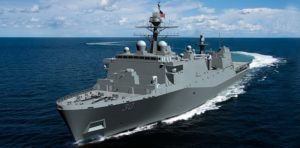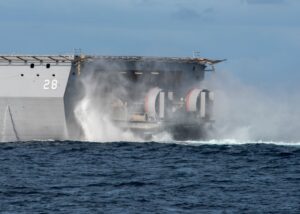The Commandant of the Marine Corps on Thursday argued in favor of getting multi-year procurement authority to buy multiple San Antonio-class Flight II ships at once to maintain and improve the amphibious fleet.
Speaking at the Amphibious Warship Industrial Base Coalition’s annual congressional forum on March 9, Gen. David Berger laid out how the Chinese military leadership decides to potentially invade Taiwan based on several factors, with a key one being U.S. forces in the region. He noted his job is to help “make sure that we have the amphibious fleet that is capable of driving that decision into: not today, not this week.”

(Image: Huntington Ingalls Industries)
Berger said the primary factor in order to both deter and win a conflict with China, if it erupts, is resourcing the proper amphibious capabilities.
“I’d argue…that it starts with resourcing the capabilities that we need to prevent that conflict in the first place from ever happening. That’s the LPD Flight Two – using tools like multi-year buys to make sure that taxpayers get their dollar’s worth. We have bought these one at a time. That’s not the way you do it. We do block buys for other platforms, for all the right reasons: destroyers, submarines, aircraft carriers, all the right reasons. We need to do it also for amphibious ships.”
Berger told the audience of congressional staffers and companies that make parts for amphibious ships they know better why multi-year buys are needed, because it signals long term work to spur investment.
“That’s the signal that tells you all we have 10, 15 years worth of work, this is not one at a time. I couldn’t agree more. We have to be on two year centers with LPDs, we have to be on four year centers with LHAs. That’s how this nation produces.”
As recently as in the fiscal year 2022 defense authorization bill, Congress extended unused authority for the Navy to procure LPD-32, LPD-33, LPD-34 and the America-class LHA-10 at once to save funds and stick closer to those centers, or time between procurement starts (Defense Daily, Sept. 28, 2021).
However, earlier in 2021, Acting Assistant Secretary of the Navy for Research, Development and Acquisition (ASN-RDA) Jay Stefany said the Pentagon intended to delay the decision to buy past LPD-32 until after working on the FY ‘23 budget cycle and new force structure analyses (Defense Daily, June 9, 2021).
Then, a year ago, Stefany told reporters the Navy’s plan to buy LPD-32 in FY ‘23 allowed time to decide on what comes after it, since two year centers means the decision on LPD-33 or a different option would not be needed until the FY ‘25 budget request, at the latest (Defense Daily, April 22, 2022).
Most recently, in February, Secretary of the Navy Carlos Del Toro said once the newest Battle Force Ship Assessment and Requirements study is complete he thinks it will show a need to continue building “LPD-like ships well into the future” (Defense Daily, Feb. 22).
Tom Rivers, executive director of the Program Executive Office Ships at Naval Sea Systems Command, confirmed there is no internal talk about walking away from the San Antonio-class Flight II, just looking for ways to reduce costs (Defense Daily, Feb. 27).
Berger also dismissed criticisms that amphibious warships are not survivable enough by illustrating analyses suggesting any conflict with China will result in many losses of all kinds of naval vessels.
“I believe that argument is completely illogical. That argument only stands up if our strategy doesn’t, in other words.”

Berger underscored in every war game he has participated in in the last five years where the U.S. and China enter a naval conflict, it is “pretty much the same outcome. If it’s against the [People’s Liberation Army Navy], it’s going to be a slugfest. We’re going to lose two carriers. We’re going to lose multiple submarines, we’re going to lose 15, 20 destroyers and cruisers. So does that mean those platforms are not viable? We should stop buying them? Of course not. We lost more than 5,000 helicopters in Vietnam. We didn’t stop buying them because we need them.”
He also noted he participated in a 2014 study that decided the LPD Flight Two was needed next to replace the Whidbey Island/Harpers Ferry-class Dock Landing Ships (LSDs).
“I don’t buy any arguments that [says] I don’t know why we have Flight Twos because they’re not the viable platform. I went through a year and a half with the Navy of studying that and we got to the right answer – LPD is today. Flight two is what we need right now.”
However, Berger said the Navy, Marine Corps and industry needs to start seriously thinking about what comes after the LPD Flight II, “and we don’t have unlimited time to do that.”